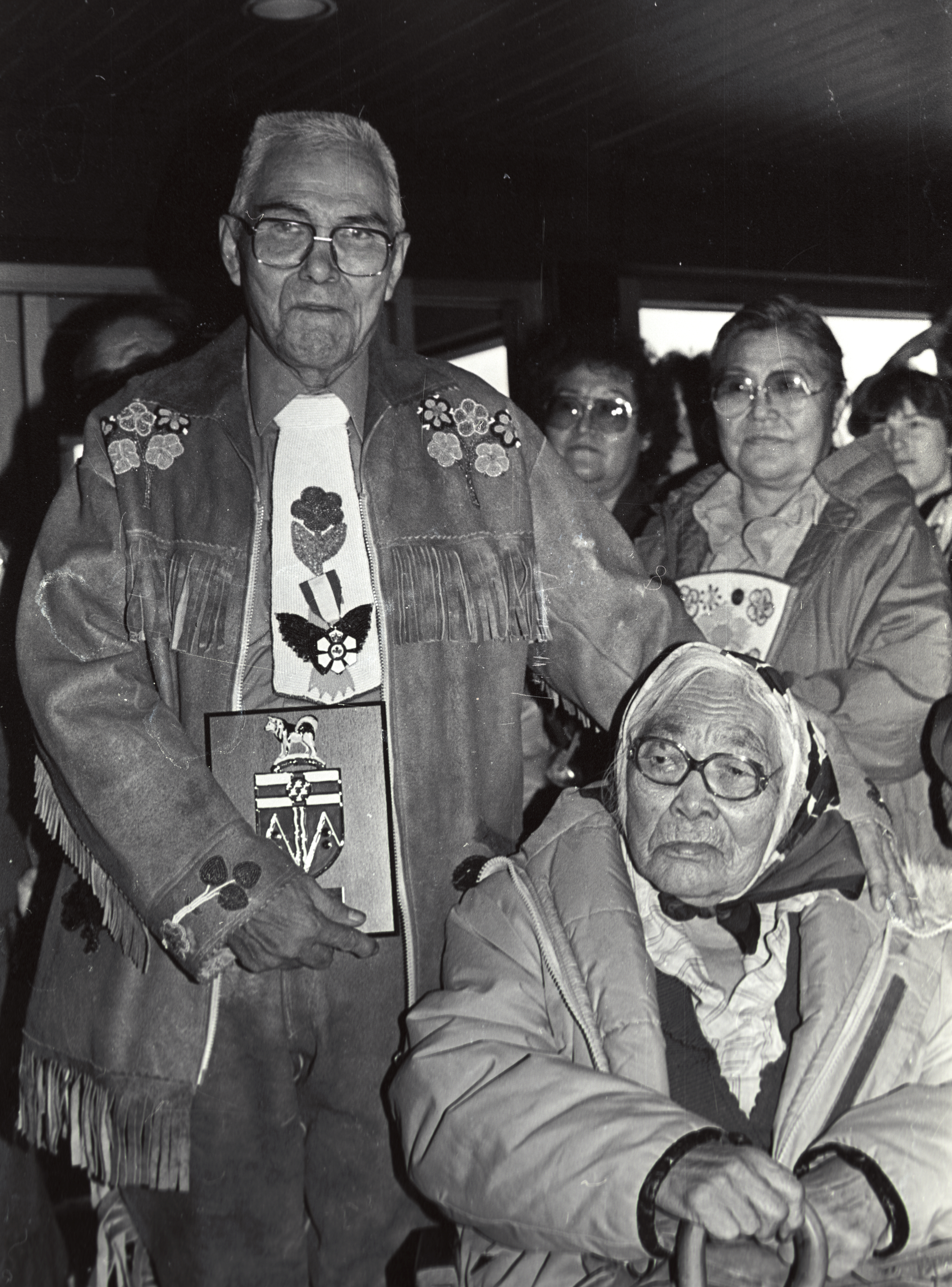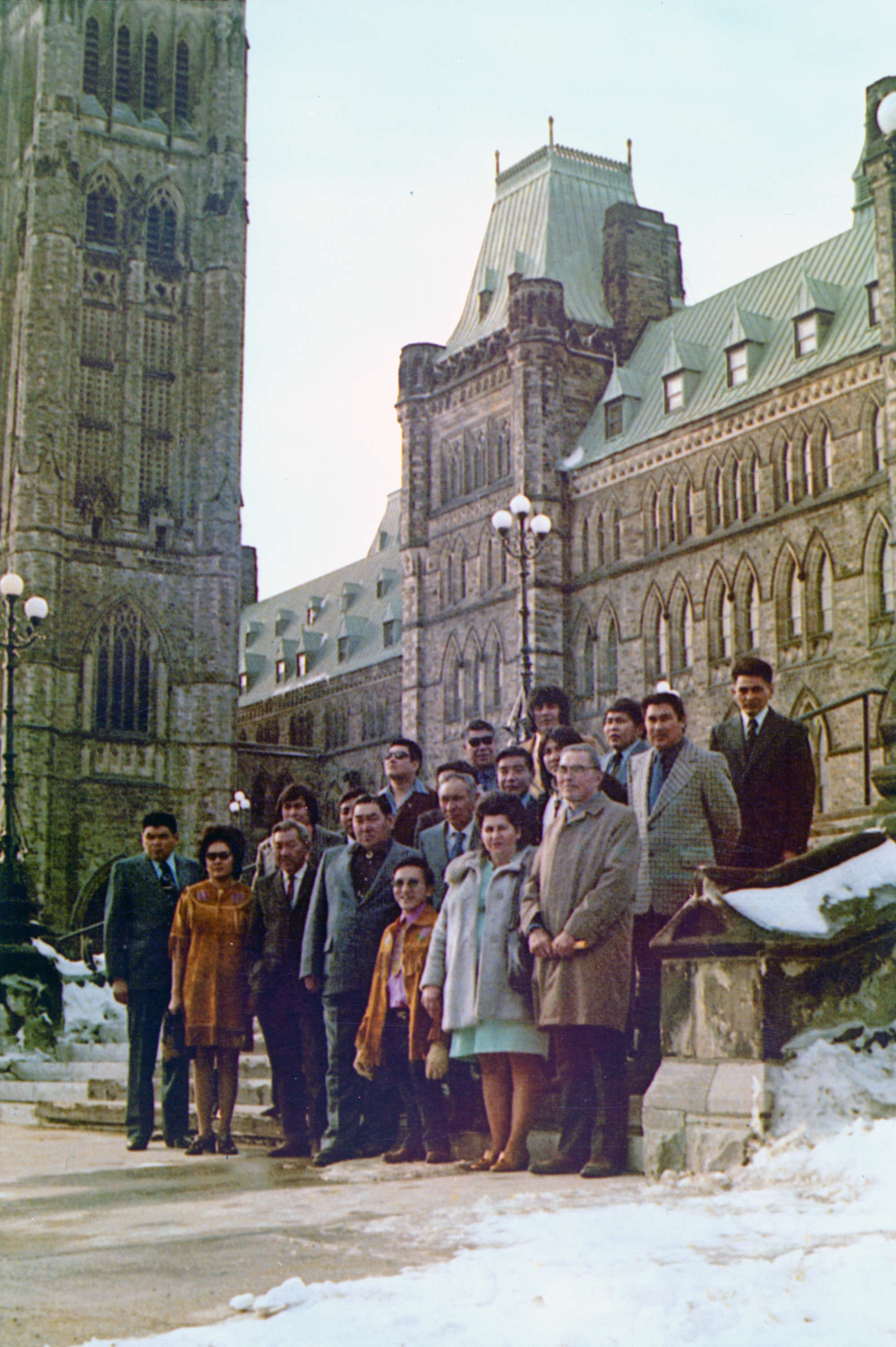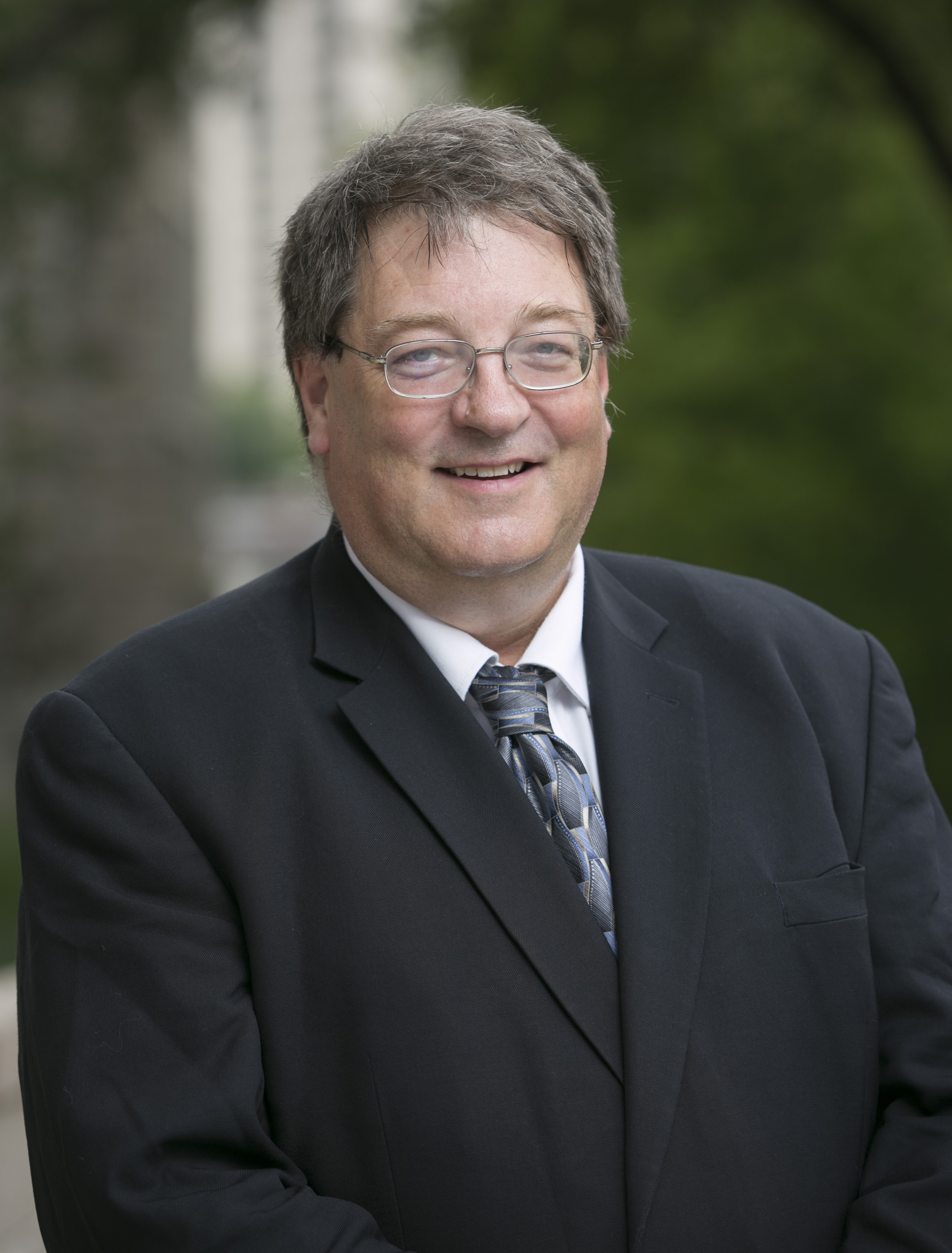Chapter 4 – Yukon First Nations’ Relationship with Newcomers
Creating a Strong United Voice
Throughout the late 1950s and the following two decades, resource extraction developments were proposed by governments and businesses, bringing the issue of economic development and land rights to the forefront (Berger 1977; Lysyk 1977). One example of development that occurred without Indigenous consultation was the territorial government’s granting of oil drilling exploration rights in the Old Crow Flats in 1970.[1] The Old Crow Indian Band (Vuntut Gwitchin Government) asked for an injunction on exploration in the area, as it was, and continues to be, an important place for the Vuntut Gwitchin peoples (Government of Yukon and Vuntut Gwitchin Government 2006). This was one of the earliest instances of Indigenous opposition to development. Community leaders petitioned the House of Commons, claiming the land as their own since they were the original occupants (Coates 1993:237). The federal government disagreed, saying that they had no rights to the land because they had not signed any treaties. In many respects, this signified the emergence of the land claims movement.
It was during this period that Indigenous organizations, such as the Klondike Indian Association (KIA), Yukon Indian Advancement Association (YIAA), Yukon Native Brotherhood (YNB), Yukon Association of Non-Status Indians (YANSI) (see section A Dynamic Future, Figure 5.4), and the Council for Yukon Indians (CYI), were established. These organizations had specific goals in mind, including the settlement of Yukon land claims, the election of an Indigenous Yukon citizen to the Yukon Territorial Council, and discussions pertaining to economic and social issues. In 1968, leaders such as Chief Elijah Smith (Figure 4.5) of the Whitehorse Indian Band[2] and a delegation of Yukon Chiefs (Figure 4.6) met with Jean Chrétien, then Minister of Northern Development and Indian Affairs. They met to discuss their concerns regarding the way Indigenous affairs had been managed, to have their outstanding grievances heard, and to focus on the land claims question. Their statement of concerns included the following:
We, the Indians of Yukon, object to being treated like squatters in our own country…We feel the (non-Aboriginal) people of the North owe us a great deal and we would like the Government of Canada to see that we get a fair settlement for the use of the land. There was no treaty signed in this country, and they tell me the land still belongs to the Indians (Chief Elijah Smith in Kwanlin Dün First Nation 2013:67).
Five years later, in 1973, the Yukon Native Brotherhood produced the document Together Today for Our Children Tomorrow: A Statement of Grievances and an Approach to Settlement by the Yukon Indian People. This document was in response to the growing question of land ownership at a time when economic development was encroaching on the traditional territories of Yukon Indigenous peoples. Yukon Chiefs, including Chief Elijah Smith, presented the document to Prime Minister Pierre Trudeau in Ottawa.[3]It described initiatives necessary to address the changing social and cultural situation in Yukon, such as:
Remembering Chief Elijah Smith

In his own words, former CBC and CKRW broadcaster Les McLaughlin remembers Chief Elijah Smith:It was a historic day for native [Indigenous] people in Yukon. In February 1973, representatives for the Yukon Native Brotherhood were in Ottawa to present their Yukon land claim. Led by Chief Elijah Smith, they delivered a document called “Together Today for Our Children Tomorrow” to Prime Minister Pierre Trudeau. The meeting is often heralded as the turning point for settlements of aboriginal rights in Canada. I was there that day, and well recall that they impressed the Prime Minister with the presentation, and with the ad-libbed words of wisdom from Elijah Smith. Later that year, the Yukon Native Brotherhood and the Yukon Association of Non-Status Indians joined forces to form the Council for Yukon Indians to further the land claim process that had just begun.
Edward Elijah Smith, the son of Annie Ned, had a lot to do with that. He was born on July 12, 1912, in Champagne, and lived in Yukon all his life except the six years he spent with the Canadian Army overseas during WW II. However, it was in Yukon that Elijah Smith became a fighter. By the mid-1960s, Yukon First Nations, fearful of losing their cultural identity, began to organize. During hearings on the federal white paper in Whitehorse in 1968, Smith spoke of being treated like squatters in their own country. He said that Yukon Indians wanted the government of Canada to see that we get a fair settlement for the use of the land. Elijah Smith was the founding president of the Yukon Native Brotherhood and was also a founding Chairperson of the Council for Yukon Indians, since renamed the Council for Yukon First Nations. He encouraged Yukon native people to stay in school. Many of these students would eventually play instrumental roles in land claims and self-government negotiations.
He served as Chief of the Kwanlin Band, founding President of the Yukon Native Brotherhood, founding Chairman of the Council for Yukon Indians, and Yukon representative to the National Indian Brotherhood. He spoke persuasively of the need for unity among First Nations people long before his vision was widely accepted. Twenty years after Elijah Smith led a group of Yukon native people to Ottawa, they signed the umbrella final land claim agreement, setting the stage for the completion of modern-day treaties for each of Yukon’s 14 First Nations.
Chief Smith held an honorary degree of Doctor of Laws from the University of British Columbia and was named to the Order of Canada. He remained a prominent figure throughout the land claims process until his death in a tragic accident in October 1991. To honour his memory, the federal building in Whitehorse is named for him, as well as the Elijah Smith Elementary school in Whitehorse, opened on September 8, 1992.
A CKRW Yukon Nugget by Les McLaughlin, Courtesy Marg & Rolf Hougen (2016).
- facilitating Indigenous input into social programs that affected them,
- creating culturally sensitive programming for seniors,
- supporting the promotion of cultural identity,
- providing people with the ability to plan their own community-development strategies and programs,
- appointing an education consultant who would act as a liaison between the Department of Education and the Indigenous community,[4] and
- allowing Yukon Indigenous peoples to create their own economic base and involving them in economic decisions that affect them. For instance, consulting them when oil leases are going to be granted, when hydro dams are going to be built, when national parks are going to be established, when mines are hiring employees, when waters are going to be polluted, and when pipelines are going to be built [Council for Yukon Indians 1977].
The presentation of Together Today for Our Children Tomorrow started what became a 20-year negotiation between Yukon Indigenous groups and the federal and territorial governments. There were various starts and stops along the way, some of which occurred because of Indigenous disagreements on specific issues, while others happened because of decision reversals by the federal government (The Long Journey Home Part 2, Northern Native Broadcasting 1997: 00:36:00). After 16 years of negotiations, an agreement in principle was reached in 1989. The Yukon Indian Land Claim Framework Agreement was approved by the Chiefs and signed by Yukon and federal governments. On May 29, 1993, all the negotiators signed the Umbrella Final Agreement (Canada 1993). Individual First Nations then began negotiating and ratifying their individual final agreements. A discussion of contemporary land claims, the Umbrella Final Agreement, and present-day independent First Nation governments can be found in chapter 5.

Historians in Yukon: Dr. Ken Coates

Ken Coates is a Canadian historian who is currently a professor and Canada Research Chair in Regional Innovation in the Johnson Shoyama Graduate School of Public Policy at the University of Saskatchewan. He was born in Banff, Alberta, raised in Revelstoke, British Columbia, and moved to Whitehorse at the age of six. He remained in Yukon until he went to university. He attended F.H. Collins Secondary School. He decided to go to university because a high school teacher told him “Yukon kids were not well prepared for university studies and should expect not to do well.” Ken set out to prove his teacher wrong, and he did. He received his bachelor’s degree in history from the University of British Columbia, his master’s in history from the University of Manitoba, and his doctorate in history from the University of British Columbia.
Ken has been conducting research in the North since the early 1980s. Ken’s early work concentrated on late nineteenth-century and twentieth-century Yukon, with a specific focus on the Hudson’s Bay Company; later, he focused on residential schools and Yukon land claims negotiations. His current research is concerned with Indigenous rights, treaties, and economic conditions, as well as regional innovation in Northern Canada. He co-directs “a multi-year project designed to generate public policy discussion and development on Aboriginal participation” in the natural resource sector.
Ken feels his career is full of highlights. One significant highlight was working with Northern Native Broadcasting (NNBY) to create The Mission School Syndrome, a documentary based on “Betwixt and Between,” a paper Ken wrote about the history of the Carcross Residential School. Some other highlights for Ken include his involvement in the negotiation of revisions to the Yukon Act (Canada 2002), and an exciting time in the 1980s when he was invited to give a talk to Whitehorse City Council and the mayor on the history of Yukon’s Indigenous peoples. Ken also participated in a United Nations workshop held in Whitehorse on negotiated land claims from around the world. He says, “Because of the work I have done in the Yukon, people have invited me to numerous places all over the world to give talks on the stories and the experiences of the Yukon. I have had marvelous opportunities to talk about Yukon history and Yukon public affairs.”
Ken has collaborated with First Nations and Indigenous peoples across the country and has been able to apply what he’s learned from Yukon in many different places. He speaks of countless benefits of this collaboration, including learning about the limitations of his own worldview and realizing that he had been seeing the world with a particular lense. Through his work with First Nations, he has learned the value of patience and has come to understand that change takes place over seven generations rather than in seven days. For Ken, “It has been a staggering privilege to work with First Nations in many different areas.” Through his work, he has also learned about the limitations and strengths of documentary records, the suspicion Indigenous peoples have of academics generally, and how Indigenous peoples like to tease academics.
Asked to name what he likes best about Yukon, Ken says, “The best place on the planet is Tagish Lake. I’m a kid of Tagish Lake; my father and I built a cabin on that lake. That place is home to me; it is where I go to fill my spirit up.” He goes on to say, “I think the Yukon is in the process of setting a global standard for how Indigenous and non-Indigenous people can work together. I’m old enough to remember the Yukon in the sixties and the conversations about Aboriginal issues in elementary and high school. I remember that world; I remember when very few First Nations people lived in Riverdale. Yukon has changed in some really remarkable ways. It’s not perfect—there are a lot of tensions and issues—but it’s a place of optimism and creativity, and for me that is an indication that the world can change in a constructive and positive way. At the end of the day we may be able to find real partnership. That’s the best part of the Yukon.”
- Prime Minister Diefenbaker supported the idea of northern Canada as a resource rich area in the mid-1950s. The extraction of commodities such as oil, lumber, minerals, gas, and hydroelectric power began in earnest during the mid-twentieth century. ↵
- Some of the recommended education changes included the fostering of two-way communication channels between parents, teachers, and students, and between Yukon Native organizations and the federal and territorial governments; the revival and re-establishment of Indigenous languages; the inclusion of accurate Indigenous history and culture in the school curriculum, as well as information about Indigenous people’s contributions to Yukon life; and assistance in the development of Indigenous teachers (Yukon Native Brotherhood 1972). ↵
- Prime Minister Diefenbaker supported the idea of northern Canada as a resource-rich area in the mid-1950s. The extraction of commodities such as oil, lumber, minerals, gas, and hydroelectric power began in earnest during the mid-twentieth century. ↵
- Some of the recommended education changes included the fostering of two-way communication channels between parents, teachers, and students, and between Yukon Native organizations and the federal and territorial governments; the revival and re-establishment of Indigenous languages; the inclusion of accurate Indigenous history and culture in the school curriculum, as well as information about Indigenous people’s contributions to Yukon life; and assistance in the development of Indigenous teachers (Yukon Native Brotherhood 1972). ↵

